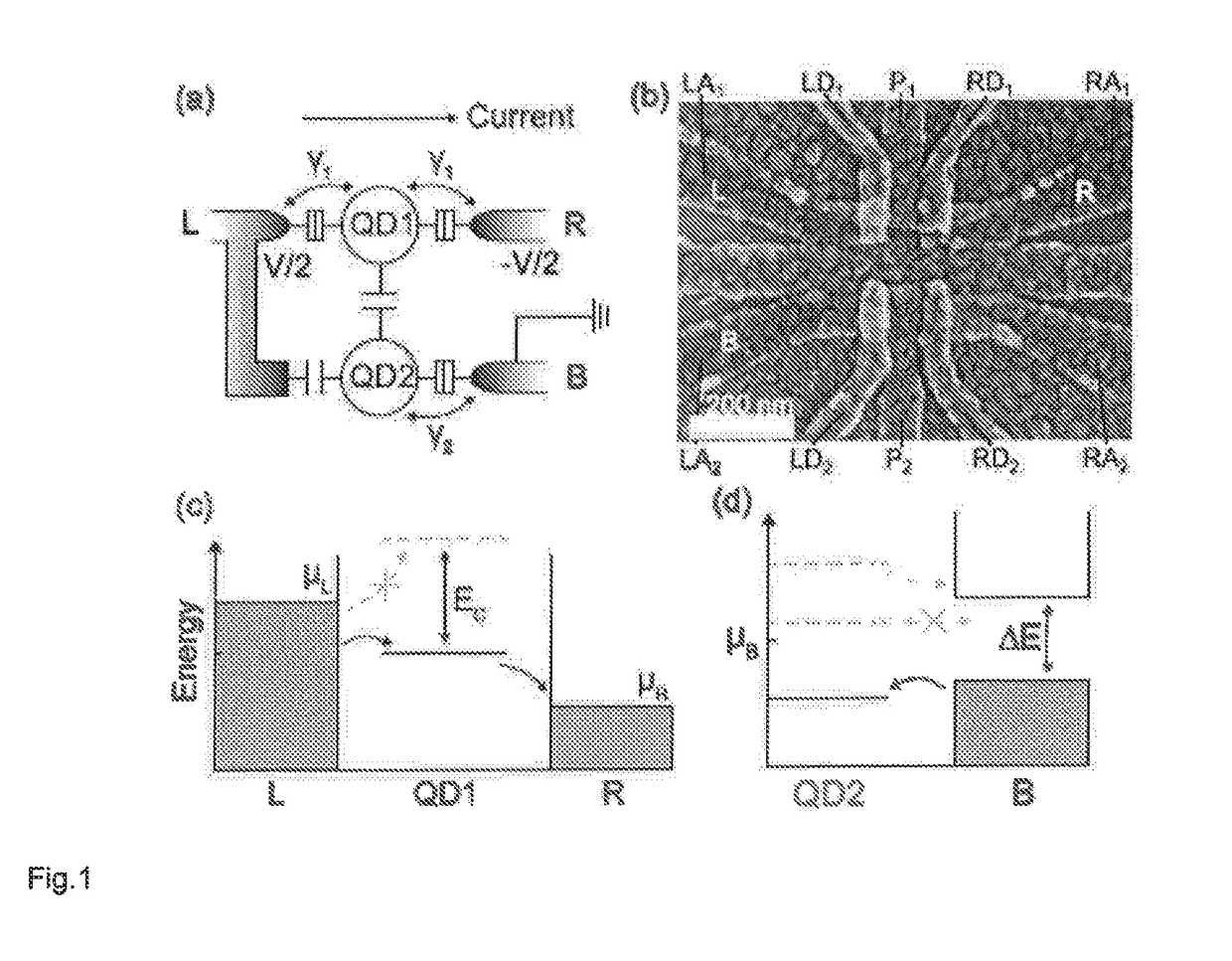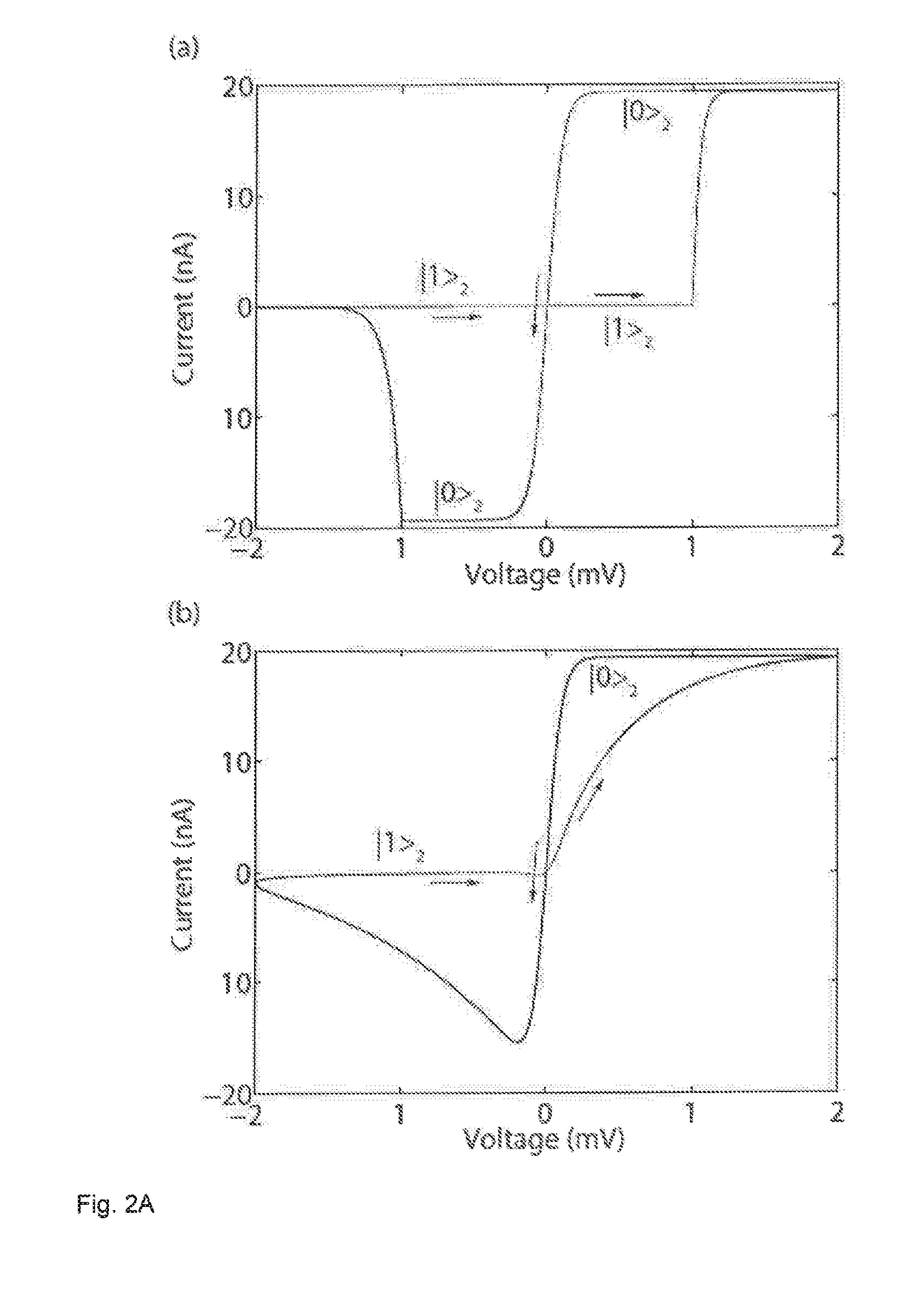Coupled quantum dot memristor
a quantum dot and coupled technology, applied in the field of coupled quantum dot memristor, can solve the problems of pinched hysteresis, or lissajous loop, no quantum-dot-based memristive device has been described up until now, and the use of a double quantum dot system as a memristive device has not been explored
- Summary
- Abstract
- Description
- Claims
- Application Information
AI Technical Summary
Benefits of technology
Problems solved by technology
Method used
Image
Examples
example 1
[0111]FIG. 1 illustrates a schematic of a quantum-dot memristive system according to the invention. As shown in FIG. 1(a), the device has two terminals: electrode-L and electrode-R. When a voltage V is applied on the device, electrochemical potentials in these two electrodes are respectively μL=|e|V / 2 and μR=−|e|V / 2. The two terminals are coupled to the quantum dot QD1 via tunnelling with the strength γ1, hence current can go through the device via QD1. The quantum dot QD2 is capacitively coupled to QD1 and to the electrode-L and is coupled to electrode-B via tunnelling with the strength γ2. The electrochemical potential in the electrode-B is μB=0.
[0112]FIG. 1(b) is an SEM image showing an experimental embodiment of a memristive system according to the invention. Three layers of aluminium gates were used to define a capacitively coupled pair of quantum dots in undoped silicon. The center-to-center distance between the two dots was ˜140 nm. Labels LA1, LD1, P1, RD1, RA1, LA2, LD2, P2...
example 2
[0115]FIG. 2 illustrates simulated current-voltage curves of a quantum-dot memristive system according to the invention derived from a periodic voltage.
[0116]In the simulations shown in FIGS. 2A(a) and 2A(b), the voltage is in the form V(t)=VA cos ωt, where VA=2 meV and ω=2π×1 MHz. The temperature is T=0.3 K, the capacitive coupling between the two quantum dots QD1 and QD2 is EC=10 meV, the tunnelling coupling of QD1 is γ1=1 meV, and the lever arm of the electrode-L gating QD2 is 1. (The lever arm is the ratio between the shift of energy level E2 and the applied voltage, multiplied by the charge of an electron).
[0117]In the simulation shown in FIG. 2A(a), the electrode-B has an energy gap E=1 meV centered at the energy 0, and the tunnelling coupling of QD2 is {tilde over (γ)}2=1 μeV. When the energy level of QD2 is within the energy gap, i.e. V∈[−1 meV, 1 meV], QD2 is empty (|02) when the voltage is decreasing and occupied (|12) when the voltage is increasing.
[0118]In the simulation...
example 3
[0122]FIG. 3 illustrates quantum trajectory simulations of the instantaneous current in a quantum-dot memristive system according to the invention. Parameters are the same as described in Example 2.
[0123]FIG. 3(a) illustrates the voltage applied on the two terminals as a function of time.
[0124]FIGS. 3 (b) and (c) illustrate the current which is produced by the voltage illustrated in (a). The energy gap in the electrode-B is open (i.e. non-zero) in (b) and closed (i.e. zero) in (c). The instantaneous current (solid curve) is different from the average current (dashed curve) due to quantum jumps, which correspond to sudden changes of the instantaneous current.
[0125]FIG. 3(d) shows experimental data which was recorded for a working embodiment (as shown in FIG. 1(d) and described in further detail in Example 9). The solid curve is the instantaneous current and the dashed curve is the current averaged over 10 sweeps. Arrows indicate the position of abrupt current jumps. The jump position...
PUM
 Login to View More
Login to View More Abstract
Description
Claims
Application Information
 Login to View More
Login to View More - R&D
- Intellectual Property
- Life Sciences
- Materials
- Tech Scout
- Unparalleled Data Quality
- Higher Quality Content
- 60% Fewer Hallucinations
Browse by: Latest US Patents, China's latest patents, Technical Efficacy Thesaurus, Application Domain, Technology Topic, Popular Technical Reports.
© 2025 PatSnap. All rights reserved.Legal|Privacy policy|Modern Slavery Act Transparency Statement|Sitemap|About US| Contact US: help@patsnap.com



